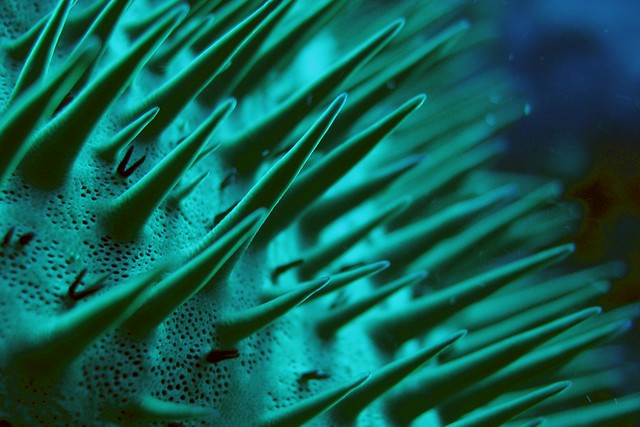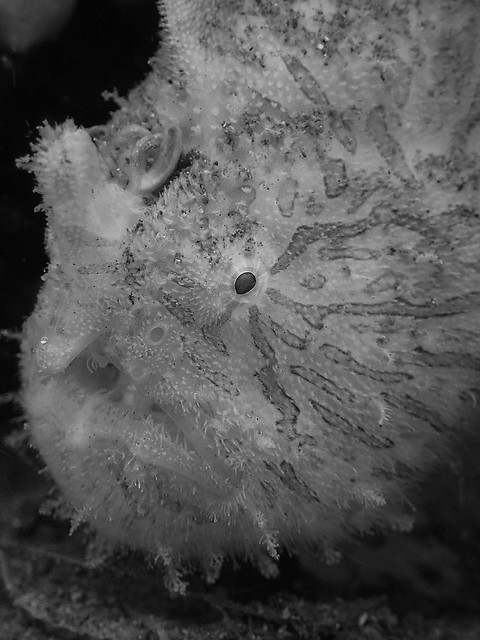Ambient Light Macro
This is about a black-belt move in underwater photography. The “Climbing the K2 without oxygen” of snapping pix underwater. The one-armed handstand breath-hold yoga pose of marine shooting. Even I haven’t pulled it off that often.
If you want to take a macro underwater photograph (a picture of a tiny animal, like a sea slug or shrimp) then you need a strobe to illuminate the subject, you have been told. And, in order to avoid unsightly shadows, you’d rather even have two strobes, so that you can aim them at different angles and no part of the scene is left in the dark. Then you can use low ISO values (resulting in low-noise images), a high f-stop (giving a large depth of field) and, of course, a fast shutter speed. The shutter speed should not even matter that much, since little of the light for the exposure will come from the environment, and naturally the shutter speed determines how long the ambient light has to fall onto the camera’s sensor. If the light is mainly coming from a very brief strobe flash, then the duration the shutter is open to allow ambient light in is less relevant. So goes the how-to for balanced (1 light source) exposure macro photography.

True, but there is an alternative way of shooting macro. For the longest time it was only known among the Hawaiian Jedi branch of underwater photographers, but I will let you in on the secret here. If you don’t hear from me after I make this sacred knowledge public, you can imagine what happened (I probably went diving).

This supremely difficult method of underwater macro shooting is called “ambient light macro”. The light for the exposure of the photograph comes from the sun only. No strobe is used. There will inevitably be less light the deeper you are, the worse the viz is, the rougher the ocean, and the less sunny it is. Hence ambient light macro should best be attempted in shallow water, with good viz, on a calm sunny day at noon. Still, the brightness will not be near what it is with two powerful strobes. How do we make up for that? With a multi-pronged approach: We need to up the light sensitivity of our camera sensor via higher ISO values (but not too much, otherwise the images become grainy). Then, we will need to reduce the f-stop, which will reduce the depth of field. That can even look appealing, when it’s done right. Remember: if the animal has eyes, these need to be in focus. A shallow depth of field can draw the viewers’ attention to one part of the photograph. Lastly, since the photons for our shot come from the ambient light, the shutter speed matters. The longer we leave the shutter open, the more photons we can collect. The downside of this is that a longer shutter speed leads to blurry photographs when we hold the camera in our – always to a certain degree shaky – hands. What is the solution for this dilemma? Wedge it into the ground! Of course we don’t want to break off any corals or sponges in the process, but if you find a rock or sandy area next to your subject, just put the camera down and stabilize it in this way. This of course only works if your photo subject is not likely to escape even if you place a camera right next to it – seastars, slugs or corals are slow or immobile and very worth photographing, but I have also succeeded in shooting a more active pipefish with ambient light macro.

A good question to ask is WHY would we even want to do this? To this the Hawaiian underwater photo Jedis answer that sometimes, the underwater shooter swims along with a point & shoot camera. These smaller cameras, like the Olympus TG-2 Tough I was using lately, don’t have exchangeable lenses, but often a special “super-macro mode”. When engaging this mode, the lens arrangement inside the camera mechanically changes, and it’s set to photographing very small things. These ultra-macro modes work very well, but usually don’t allow the use of a strobe. Hence ambient light macro it is. Typically, the aforementioned camera settings are automatically chosen by the point & shoot in super-macro mode. While a point & shoot with a super-macro mode is great for ambient light macro, you can also do it with an SLR, you will just have to adjust the camera settings yourself. A second reason for using ambient light macro is that we as good underwater photographers always want to experiment and try something new! The light in these pictures will be more even, leading to less harsh looking images than it’s often the case with conventional strobe-based macro. Give the technique a shot on your next dive!
If you enjoy my elaborations about all things underwater photo, why not join me at the Evolution Photoganza 2014, this September in Malapascua, Philippines!
